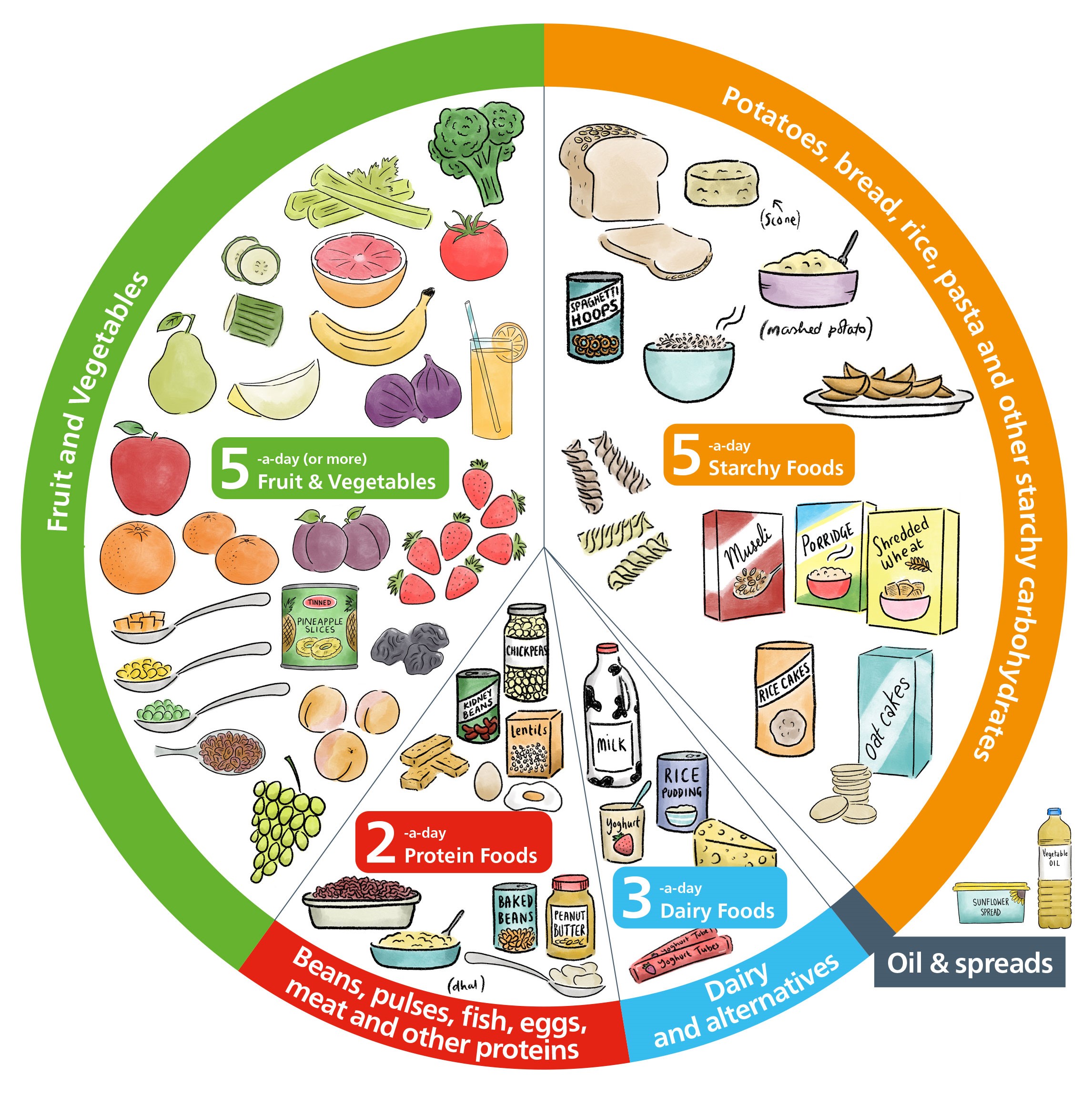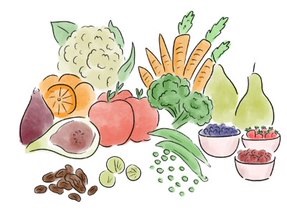Healthy Eating
Ensuring your child has a healthy balanced diet including fibre and that they have plenty to drink is important.
Eatwell Plate
The Eatwell Plate shows you what proportion of your food needs to come from each food group

Portions: 5 portions of fruit and vegetables a day, 5 portions of starchy foods (like potatoes, bread, pasta, rice) a day, 3 portions of dairy and alternatives a day, and 2 portions of protien foods (like beans, pulses, fish, eggs, meat) a day.
Portion sizes
- Fruit and Vegetables - 1 portion is the size of your cupped hand
- Starchy carbohydrates - 1 portion is the size of your fist
- Proteins - 1 portion is the size of your palm, not including fingers and thumb
- Dairy - 1 portion is the size of your index and middle finger
- Oil & spreads - 1 portion is the size of the tip of your thumb
What is fibre?
Dietary fibre is the part of fruit, vegetables and grains that cannot be digested. It is an important part of a balanced diet because it:
 Helps the bowel to work properly.
Helps the bowel to work properly. - Adds bulk and softens the stool by holding water. This can help prevent or relieve constipation.
- Promotes the healthy growth of bacteria in the bowels.
Increasing fibre intake
As you start to eat more fibre you may have some bloating and wind at first, this usually settles as your gut gets used to the fibre. If you are not used to fibre it is best to increase the amount gradually.
There are two types of fibre
Soluble (able to dissolve): this type of fibre is broken down by natural bacteria in your bowels, making your stool softer and larger. It can be found in fruit (but not skins), oats, barley, vegetables and pulses
Insoluble (unable to dissolve): this type of fibre passes through your body mostly unchanged, but it does absorb water. This increases the size of your stool so it passes through the bowel quicker. It can be found in nuts, fruit and vegetables with skins and pips, wholegrain cereals such as wheat, rye and rice.
Recommended Daily Intake
The Association of UK Dieticians recommends normal daily fibre intake (from 2 years) should be as follows;
| Age | Amount of Fibre a day |
| 2-5 years old | 15g |
| 6-11 years old | 20g |
| 12-15 years old | 25g |
| 16+ | 30g |
If you aim for a healthy balanced diet, using wholemeal versions of carbohydrates and 5 portions of fruit/vegetables a day, you should achieve this without having to count.
Don’t suddenly increase the amount of fibre in your diet. Suddenly increasing the amount of fibre you eat may make you feel bloated or have stomach cramps. Make one change at a time. Make sure you drink more fluids as you increase the amount of fibre you have, fibre absorbs fluids.
Fruit and vegetables that are high in fibre include apples, berries, figs, pears, prunes, oranges, peas, cauliflower, broccoli, brussel sprouts and carrots. Tinned, frozen or dried fruit and vegetables all count.
Special considerations
Salt
- Keep salt intake within the recommended limits, reduce the risk of health problems in later life.
- Use herbs, spices or lemon to flavour food instead of salt.
- Do not add salt to food
- Limit salty snacks like crisps
- Reduce the amount of processed salty foods such as ready meals and processed meats.
Eggs
- Babies can have eggs from around 6 months
- Young children should avoid raw or lightly cooked hens’ eggs unless they have a red lion stamped on them (the British Lion Quality mark).
- Eggs (including duck, goose or quail) that do no have the red lion mark should be cooked until both the white and yolk are solid.
Nuts
- Whole nuts should not be given to children under the age 5 years because of the risk of choking
- You can give your baby nuts and peanuts from around 6 months old, as long as they’re crushed, ground or a smooth nut or peanut butter.
Low-calorie foods
- For most children there is no need to offer ‘low-calorie’ or ‘low-fat’ foods because children of this age need lots of energy for growing and for physical activity.
- However, once a varied diet is accepted and provided your child is growing well semi-skimmed milk can be introduced from 2 years.
Sugar
- Foods which are high in sugar and fat will provide extra energy but few nutrients.
- High sugar intakes often lead to tooth decay and can lead to obesity in children.
- It is important to avoid giving your child frequent sugary drinks, snacks or sweets to protect their teeth and overall health.
- If you want to give them something sugary, it is best to limit these to twice per week or at mealtimes.
Shark, marlin and swordfish
- Children under the age of 16 years should avoid eating any shark, marlin or swordfish as they contain high levels of mercury and can affect a child’s development.
You can reduce the fat by adding less butter to mashed potato or on bread and using less oil in cooking. Using a spray bottle can help to reduce oil use. Changing your cooking methods can help to reduce the amount of fat in your child’s food.
Rather than frying food, try grilling food, steaming food, or baking food. These cooking methods reduce the fat content compared to frying.
It’s not just about what your child eats, but also the environment around them when they are eating. When children eat with other members of the family and have the same meals, this encourages children to enjoy a variety of foods. If you can, try to sit down and eat meals as a family. Avoid the distractions of the television or computer games so children can focus on the taste, smell and texture of their food and recognise their feelings of fullness. Snacking can also affect a child’s eating habits and can mean that they don’t have a balanced diet. Try to keep snacking to twice per day and opt for fruit and vegetables, in place of snacks high in fat, salt and sugar.
Making it fun!
Food and eating should be enjoyable and fun! Children love to get involved. Let them help with cooking, by putting foods in the pan or help with chopping up soft foods with close supervision. Take them to the shops to help choose different foods. Exposure, exposure, exposure! Repeatedly offering a food, so that it becomes familiar. You might need to offer some foods 5 - 15 times or more before your child learns to like them, but they should get there in the end so do not give up! Talk to your child about healthy eating, this will create a positive relationship for your child in relation to food. Teaching your child about food during playtime can increase their familiarity with different foods, is known to increase children’s willingness to try it and eventually to like it. Ideas include; Growing your own food, Messy food-related play, and Reading stories and singing songs about healthy food.
Pressurising or coercing your child into eating certain foods can sometimes work in the short-term. However, this tactic may backfire because your child is likely to develop negative associations with the food and be even less likely to eat it in the future.
Aim to create a healthy home environment that is conducive to healthy eating. Stock up on healthy foods from the four main food groups and try to avoid having foods high in fat, salt and sugars on display or in your child’s reach. ‘Modelling’, that is, allowing your child to learn from watching how you behave, has been shown to be an effective way to encourage children to accept new foods so lead by example and eat the foods that you would like your child to eat. It is also a good idea to limit your child’s exposure to food advertising, for example by limiting their screen time, as this might negatively influence your child’s food preferences by encouraging liking of foods high in fat, salt and sugars
A reward chart for food is a great way to encourage children to try new foods or to try different coloured foods. Eating a variety of foods is really important for healthy growth and development.
How to complete the Food Reward Chart
The best approach is to offer foods in a relaxed way and to let your child decide how much they want to eat. When your child tries a new food or eats something they previously refused, even if it’s only a tiny piece, praise your child. Praise can help children to develop positive associations with food which will mean that they will be more likely to eat them again in the future.
Completing a Food Diary
A food diary is a really useful way to record everything that is being eaten throughout the week. Complete the Food Diary carefully for one week. Include as much detail as you can about breakfast, lunch, dinner and snacks. It is important to have a good understanding of your child’s current diet to know be able to assess the variety and fibre content of the food they are eating.


